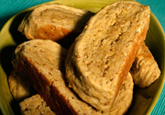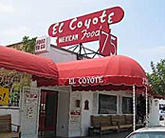The time of day won't matter. Meals -- be it breakfast, lunch or breakfast -- will be a substantial part of your visit to Queens. Which gives you two options: You can follow your explorer instincts and get into the first place that intrigues you and hope for the best. It's a respectable option. But you can minimize the risk that it entails by looking a little bit into what variations of what ethnic food each area is best suited for.
Here's some suggestions to guide you:
Greece has no breakfast tradition. Historically, Greek farmers just had a cup of something warm before setting out to tend their crops. This has generally been respected throughout the ages and, to this day, people in Greece don't eat as soon as they wake up as many other cultures do. This is what makes Queens' most Greek neighborhood ideal for your breakfast.

You see, Greeks usually stop whatever they are doing halfway through the morning (at 10-11 am) and enjoy a kolatsio, which is a snack usually heartier than your muffin-and-coffee offer at a given menu. Even if they are working, they will stop whatever they are doing to eat at the closest bakery -- which is something you too can participate in if you start your day in Astoria. Even if most of this neighborhood's residents are at work in the city, you will see housewives and children leave their houses to share their kolatsio with their neighbors.
One tip if you are going to eat at a bakery store: ask if they have paximathakia and koulourakia. These justly sugared cookie twists will give you brand new appreciation for Greek culture.
Unless you are Greek yourself. If so, you might prefer to try some exotic tea at the Czech restaurants.
It would be redundant to state how diverse the population in each New York neighborhood is. But it be equally remiss to ignore how much this has benefited Richmond Hill -- an area with European foundations which then welcomed Caribbeans, Africans and West Asians. Their food kind of reflects this evolution -- with a special favoritism towards the Asian.
Lunch in Richmond Hill is not recommended for soft stomachs. You could very easily find a restaurant or a diner with more agreeable, mainstream dishes to offer, but you might as well eat those anywhere. If you go to Richmond Hill, it will be to face the challenge. You can choose from different types of unknown hotness and spice: the perhaps familiar Indian or its evolved sibling Guyanese cuisines are especially good there. Then there are the Pakistani menus, if you are one for aromatic, full flavors and a hot mouthfeel.
For the faint of stomach, there is a middle-of-the-road option in the form of Bangladeshi food -- generally not as spicy as their other Asian counterparts, with many more recognizable ingredients (rice being chief among them) and the guarantee that most Bangladeshi restaurants are, indeed, owned by a true Bangladeshi New Yorker.
If you make your lunch early enough, you have the chance to walk it off in the tranquil neighborhood. And if your wandering takes you to the adjacent Ozone Park neighborhood, don't forget to ask about the racetrack.

Dinner in Jamaica is especially practical if you are staying in Manhattan, as it allows you to take the reasonably-price and effectively-speedy JFK Airtrain back to the island in less than 35 minutes, no matter what day it is, no matter what time it is.
By that logic, the wisest thing to do would be to visit El Coyote Restaurant. Not only is this senior Mexican restaurant one of the best in central Queens (which, according to some neighbors, is not saying much), but it's also next to the last stop in the F train. You will taste above average Mexican food in a lively environment. And you can let loose a little bit with the tequilas -- their selection is solid enough to warrant a relatively fresh start in the morning.
But if good ideas is what you want, note that you are in practically the only neighborhood in New York that offers Creole food. An intriguing blend of French, Spanish, Indian, Native American and West African influences, this cuisine is almost the gastronomic equivalent to New York. It's a taste you cannot leave New York without.